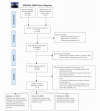Using Telemedicine to Diagnose Surgical Site Infections in Low- and Middle-Income Countries: Systematic Review
- PMID: 31429414
- PMCID: PMC6718082
- DOI: 10.2196/13309
Using Telemedicine to Diagnose Surgical Site Infections in Low- and Middle-Income Countries: Systematic Review
Abstract
Background: A high burden of preventable morbidity and mortality due to surgical site infections (SSIs) occurs in low- and middle-income countries (LMICs), and most of these SSIs occur following discharge. There is a high loss to follow-up due to a wide geographical spread of patients, and cost of travel can result in delayed and missed diagnoses.
Objective: This review analyzes the literature surrounding the use of telemedicine and assesses the feasibility of using mobile phone technology to both diagnose SSIs remotely in LMICs and to overcome social barriers.
Methods: A literature search was performed using Medline, Embase, CINAHL, PubMed, Web of Science, the Cochrane Central Register of Controlled Trials and Google Scholar. Included were English language papers reporting the use of telemedicine for detecting SSIs in comparison to the current practice of direct clinical diagnosis. Papers were excluded if infections were not due to surgical wounds, or if SSIs were not validated with in-person diagnosis. The primary outcome of this review was to review the feasibility of telemedicine for remote SSI detection.
Results: A total of 404 articles were screened and three studies were identified that reported on 2082 patients across three countries. All studies assessed the accuracy of remote diagnosis of SSIs using predetermined telephone questionnaires. In total, 44 SSIs were accurately detected using telemedicine and an additional 14 were picked up on clinical follow-up.
Conclusions: The use of telemedicine has shown to be a feasible method in remote diagnosis of SSIs. Telemedicine is a useful adjunct for clinical practice in LMICs to decrease loss to postsurgical follow-up.
Keywords: developing country; follow-up; low- and middle-income countries; postoperative; surgical site infection; telemedicine; wound infection.
©Charlotte EJ Sandberg, Stephen R Knight, Ahmad Uzair Qureshi, Samir Pathak. Originally published in JMIR Mhealth and Uhealth (http://mhealth.jmir.org), 19.08.2019.
Conflict of interest statement
Conflicts of Interest: None declared.
Figures
References
-
- Nguhuni B, De Nardo P, Gentilotti E, Chaula Z, Damian C, Mencarini P, Nicastri E, Fulment A, Piscini A, Vairo F, Aiken AM, Ippolito G. Reliability and validity of using telephone calls for post-discharge surveillance of surgical site infection following caesarean section at a tertiary hospital in Tanzania. Antimicrob Resist Infect Control. 2017;6:43. doi: 10.1186/s13756-017-0205-0. https://aricjournal.biomedcentral.com/articles/10.1186/s13756-017-0205-0 - DOI - DOI - PMC - PubMed
-
- Pathak A, Sharma S, Sharma M, Mahadik VK, Lundborg CS. Feasibility of a Mobile Phone-Based Surveillance for Surgical Site Infections in Rural India. Telemed J E Health. 2015 Mar 06;21(11):946–9. doi: 10.1089/tmj.2014.0199. http://europepmc.org/abstract/MED/25748641 - DOI - PMC - PubMed
-
- Aiken AM, Wanyoro AK, Mwangi J, Mulingwa P, Wanjohi J, Njoroge J, Juma F, Mugoya IK, Scott JAG, Hall AJ. Evaluation of surveillance for surgical site infections in Thika Hospital, Kenya. J Hosp Infect. 2013 Feb;83(2):140–5. doi: 10.1016/j.jhin.2012.11.003. https://linkinghub.elsevier.com/retrieve/pii/S0195-6701(12)00377-5 - DOI - PMC - PubMed
Publication types
MeSH terms
Grants and funding
LinkOut - more resources
Full Text Sources
Medical



